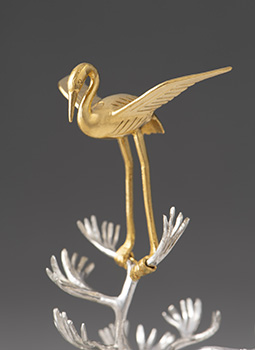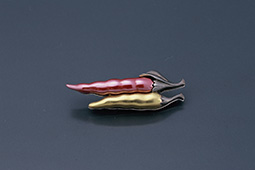March 2023
- English
- 日本語
Chasing, A Method to Draw Out the Charm of Gold

Katsura Morihito’s Mimizuku Koro (horned owl incense burner) (w. 12.5 cm x h. 10.5 cm x d. 8 cm) (1993) 
Katsura Morihito’s Kaeru Obidome Kanagu (frog metal sash clip) (w. 3.8 cm x h. 0.8 cm x d. 2 cm) (2005)

Katsura Morihito’s Kintsuru Suhamadai Fukugen Shincho (new reproduction of golden crane on Suhamadai) (Owned by Kasugataisha Shrine. The crane is about 5 cm tall.)
Photo: Ohtani Miki (Fusosha)
Katsura Morihito’s Togarashi Obidome Kanagu (chili pepper metal sash clip) (w. 5.5 cm x h. 0.8 cm x d. 2 cm) (2003)

Photo: Ohtani Miki (Fusosha)
Katsura Morihito uses traditional “chasing” metalworking techniques to create works of art from gold and other materials.

Chasing is a traditional metalworking technique in which gold, silver, copper, iron, and other materials are engraved and embossed primarily using a chisel to create shapes and decorations. The technique of chasing was perfected in around 1440. The technique was used for decorations such as the handguards and hilts of swords used by the samurai and became even more highly developed during the Edo period, a period of samurai rule under the Tokugawa Shogunate of about 260 years starting in the early 17th century. Modernization progressed in the subsequent Meiji period (1868–1912) due to the banning by government proclamation in 1876 of the wearing of swords. And, chasing techniques began to be used to make craft items such as tobacco pipes, cigarette cases, decorative sash clips attached to the obi sash of kimono, and incense burners used for the alcove and Buddhist altars.
Katsura Morihito is recognized as a holder of an Important Intangible Cultural Property (Living National Treasure) for these chasing techniques. Born in 1944, Katsura has produced many works of art since his mid 20s after training under his father who inherited the tradition of the Yanagawa school of chasing which dates back to the 17th century.
One feature of his works is that they are three-dimensional objects made from a single metal sheet 1.2–1.5 millimeters thick. Katsura gradually gives form to birds, insects, plants, and other shapes by patiently and continuously beating a metal plate with a chisel. One of his works, the Mimizuku Koro (horned owl incense burner), features a horned owl (mimizuku) as the handle used to open the lid of the burner. The sharp-eyed horned owl is so realistic that it is hard to believe it is made of metal. It is in fact made of an alloy of silver and copper known as shibuichi.
“I want to create works that make the viewer wonder if what they are looking at has just moved,” says Katsura. “However, it is really difficult to create three-dimensional works because the shibuichi alloy is extremely hard.”
Katsura’s works come in a variety of colors, with gold playing an important role in producing these colors. One of his works using gold is the Kaeru Obidome Kanagu (frog metal sash clip) made in 2005. The pale golden frog (kaeru), made with a small amount of silver added to the gold, appears still but is inlaid (see here) with brilliant pure gold for the eyes, creating the impression it might jump at any time.

“Most people probably think of the golden color of pure gold when they think of gold. But you can change the color in a variety of ways by mixing silver or copper in with gold,” says Katsura. “By using just a little bit of gold, the impression of the work changes greatly. That is one of the amazing things about gold.”
Katsura’s Kintsuru Suhamadai Fukugen Shincho (new reproduction of golden crane on Suhamadai)* is an especially impressive recent work using gold, a National Treasure owned by Kasugataisha Shrine** in Nara Prefecture, which commissioned Katsura to create the work. It is a reproduction of the Kintsuru oyobi Ginjushi (golden crane and silver branch) dedicated as a sacred treasure to the deities at Wakamiya Shrine, which is located within the precincts of Kasugataisha Shrine. Katsura in fact created two pairs of reproductions of the golden crane on the pure silver branches. One pair is housed in the Kasugataisha Museum, an art museum at Kasugataisha Shrine, and the other pair is dedicated to Wakamiya Shrine as a sacred treasure and is not viewable by the public.
“Creating the reproductions I was surprised by the quality of the chasing techniques from 900 years ago,” Katsura recalls. “Pure gold is soft, meaning the shape is easily altered as force is applied with a chisel. But actually, this means it’s very difficult to create works of art with it. Furthermore, the cranes are small, at less than 5 centimeters tall. The work of engraving detailed lines of 0.1–0.2 millimeters on the wings, body, and head was nerve-wracking each time, as it can’t be redone. Creating these reproductions took 8 months, and while engrossed in my work I was able to bring a special sentiment to it when I thought about the fact that the completed cranes would be dedicated to the deities.”

Future generations will surely be amazed by the graceful golden figures and Katsura’s advanced techniques.
* The place where the beach enters is called “Suhama,” and the stand was made to resemble the shape of the beach.
** See Highlighting Japan July 2021, “The Forest in the Sacred Precincts of Kasugataisha Shrine” https://www.gov-online.go.jp/eng/publicity/book/hlj/html/202107/202107_03_en.html

